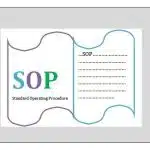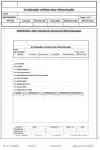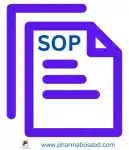Learn how to write a standard procedure SOP for calibration of HPLC (High-Performance Liquid Chromatograph) in quality control laboratory.
1. PURPOSE
To describes the procedure for the calibration of the High-Performance Liquid Chromatograph (HPLC) used in the pharmaceutical laboratory to ensure accurate and reliable chromatographic analysis of pharmaceutical products.
2. SCOPE
This procedure is applicable to the HPLC system used for the analysis of raw materials, intermediates, and finished products in the pharmaceutical laboratory.
3. RESPONSIBILITIES
3.1 Laboratory Personnel: Responsible for performing the calibration procedure and ensuring it is conducted as per this SOP.
3.2 Quality Control Manager: Responsible for ensuring that the calibration is carried out in compliance with this SOP.
3.3 Maintenance Technician: Responsible for maintaining the HPLC equipment and performing preventive maintenance as required.
4. ACCOUNTABILITY
Head of the Quality Assurance Department
5. ASSOCIATED DOCUMENTS / REFERENCES
5.1 United States Pharmacopeia (USP) Chapter <621> – Chromatography
5.2 ICH Q2 (R1) Validation of Analytical Procedures
5.3 Internal Method Validation Reports
6. PRECAUTIONS
6.1 Always wear appropriate Personal Protective Equipment (PPE) such as gloves, safety glasses, and lab coats when working with the dissolution apparatus.
6.2 Handle all chemicals and calibration standards according to their respective Material Safety Data Sheets (MSDS).
6.3 Ensure proper ventilation in the laboratory to minimize exposure to harmful vapors or fumes.
7. PROCEDURE
7.1. Equipment and Materials
7.1.1 High-Performance Liquid Chromatograph (HPLC)
7.1.2 Calibration Standards (e.g., known concentrations of compounds)
7.1.3 Solvents (e.g., HPLC-grade water, methanol, acetonitrile)
7.1.4 Analytical balance
7.1.5 Syringes and volumetric flasks
7.1.6 Standard solutions
7.1.7 System suitability test samples
7.1.8 Computer and software for data analysis
7.1.9 Sample vials and filters
7.1.10 Column (if necessary)
7.1.11 Degasser (if applicable)
7.2 Preparation of Calibration Standards
7.2.1 Prepare standard solutions for calibration using accurate and precisely weighed quantities of reference standards. The concentration of standards should cover the expected range of the analytes in the samples.
7.2.2 Dissolve the standard in the appropriate solvent, and filter the solution through a 0.45 µm filter into a clean sample vial.
7.2.3 Label the vials with the concentration, date, and other relevant information.
7.3 Equipment Setup
7.3.1 Ensure the HPLC system is in good working condition, with appropriate columns and solvents in place.
7.3.2 Verify that the instrument is connected to a power supply and that all components are functioning (pumps, injector, detector, etc.).
7.3.3 Perform any required daily maintenance, such as checking the mobile phase levels, degassing, and system flushing.
7.3.4 Turn on the HPLC system and allow it to stabilize for at least 15 minutes.
7.4 System Suitability Test (SST)
7.4.1 Perform a system suitability test with a standard solution that is known to be stable and representative of the analytes being measured.
7.4.2 Record the system’s performance by checking the following parameters:
Retention time
Peak area
Resolution
Tailing factor
Theoretical plates (N)
7.4.3 Ensure that the system meets the acceptance criteria outlined in the validation or method development protocol.
7.5 Calibration Procedure
7.5.1 Inject the calibration standards in ascending order of concentration (starting from the lowest to the highest).
7.5.2 Inject each standard in duplicate or triplicate to ensure reproducibility.
7.5.3 Record the chromatogram for each injection.
7.5.4 Use the HPLC software to integrate the peaks and calculate the area under the curve for each injection.
7.5.5 Plot the peak area versus the concentration of each standard to generate the calibration curve.
7.5.6 Ensure that the correlation coefficient (R²) is greater than 0.999 for the calibration curve.
7.5.7 The linearity of the calibration curve should be evaluated with a minimum of five concentration levels.
7.5.8 The slope and intercept of the calibration curve should fall within acceptable limits, as defined by the method validation.
7.5.9 The calculated concentration of the standards should be within ±2% of the nominal value.
7.6 Post-Calibration
7.6.1 After completing the calibration, flush the system with appropriate solvents to remove any remaining standard solution.
7.6.2 Perform a post-calibration system suitability check using the same parameters as the initial test to confirm the system’s performance is still within acceptable limits.
7.7 Record all details of the calibration procedure in the HPLC Calibration Log, including:
7.7.1 Date of calibration
7.7.2 Equipment ID and serial number
7.7.3 Calibration standards used (name, concentration, batch number)
7.7.4 Results of the system suitability test and calibration curve (e.g., R² value, slope, intercept)
7.7.5 Any deviations from the SOP
7.7.6 Signature of the person performing the calibration
7.7.7 Signature of the supervisor reviewing the calibration
7.7.8 All data and records should be stored as per the pharmaceutical company’s data retention policy for a minimum of [X] years.
7.8 Troubleshooting
7.8.1 If the calibration curve does not show a linear relationship, check for possible issues such as:
7.8.2 Incorrect standard preparation
7.8.3 Air bubbles in the mobile phase
7.8.4 Incorrect instrument settings
7.8.5 Column contamination
7.8.6 If system suitability parameters (e.g., resolution, tailing factor) are not met, check for column degradation, mobile phase composition, or issues with the detector.
8. DEFINITIONS AND ABBREVIATIONS
8.1 Calibration: The process of verifying that an instrument is providing accurate and reliable results, typically by comparing it with a certified standard.
8.2 System Suitability Test (SST): A test performed to verify the adequacy of the HPLC system’s performance.
8.3 SOP : Standard Operating Procedure
8.4 MSDS: Material Safety Data Sheets
8.5 BP: British Pharmacopeia
8.6 USP: United States Pharmacopeia
8.7 ICH: International Council for Harmonization
8.8 QC: Quality Control
8.9 PPE: Personal Protective Equipment
8.10 HPLC: High-Performance Liquid Chromatograph
9. ANNEXES
9.1 Annex-1: Log Book for Calibration of HPLC
9.2 Annex-2: System Suitability Acceptance Criteria
10. Revision History
| Version | Date | Description of Change | Reviewed By | Approved By |
| 1.0 |
Read Also:
- SOP for Calibration of Dissolution Test Apparatus
- SOP for Disposal of Rejected Materials
- SOP for Batch Numbering System of Raw and Packaging Materials.
- SOP for Operating of Steam Sterilizer
- SOP for Qualification of Working Standard
- SOP for Storage and Use of Chemical Reference Standards
- SOP for Cleaning of Sampling Tools

Abdus Sobhan Salim is professional experienced pharmacist in pharmaceuticals, author and founder of pharmabossbd.com, the first Bangladeshi pharmaceutical blogger since 2019.



